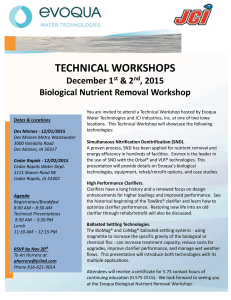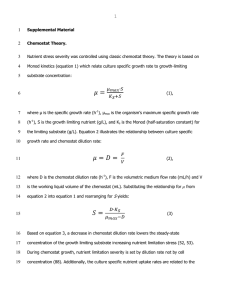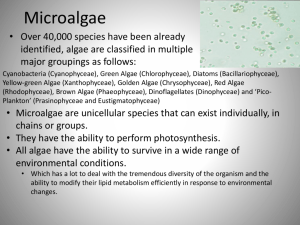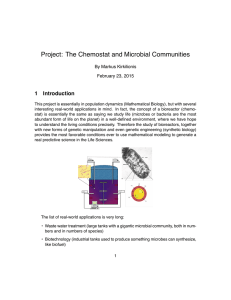Prof. Robert Gunsalus Prof. Peter Bradley
advertisement
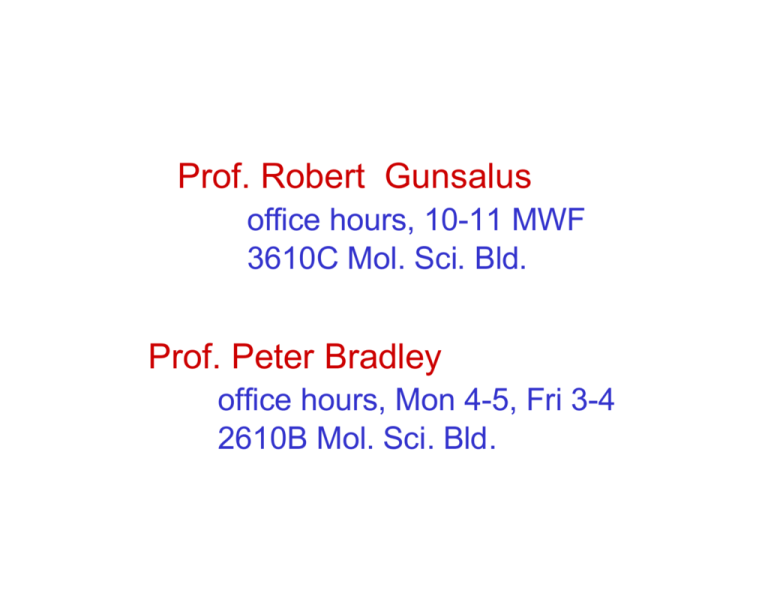
Prof. Robert Gunsalus office hours, 10-11 MWF 3610C Mol. Sci. Bld. Prof. Peter Bradley office hours, Mon 4-5, Fri 3-4 2610B Mol. Sci. Bld. Today: Cell Growth & Effect of Environmental Factors Brock, chapter 6 & p 103-110 Friday The Cell Envelope & Cell Surface Structures Brock, p 64-81, 389-390 Today’s Overview: 1. How cells grow in continuous culture. 2. Effect of environmental factors on cell growth. Batch cell culture Growth of Microorganisms Batch cell culture vs Continuous cell culture Characteristics of cell growth in Batch Culture: The system is "closed" no addition of new material no removal of waste material no removal of cells The cell density increases until…. ….something becomes limiting! A typical batch culture growth curve cell density increases at the maximum rate! Cell growth in Continuous Culture “Continuous Culture” - system is "open" - continual addition of nutrients - continual removal of cells - continual removal of waste materials As a result, cell density remains constant! Examples of microbial growth in Nature in Continuous Culture - bacteria in a stream or river - bacteria in human intestines - stomachs of cows, goats, horse, etc. How to do this in the laboratory? A chemostat device Rate of inflow is equal to the rate of outflow! the medium addition rate = vessel dilution rate Thus…under nutrient limiting conditions, the rate of nutrient addition controls the cell growth rate! Cells are growing slower because they lack sufficient carbon or some other essential nutrient they need to grow fast! And….under nutrient excess conditions, the rate of nutrient addition controls the cell yield (i.e., number of cells per ml.)! Addition rate Cell dt (doubling time) 1000 ml/hr 2000 3000 500 200 100 1 per hr 2 per hr 3 per hr 0.5 ( 2 hrs) 0.2 ( 5 hrs) 0.1 (10 hrs) Dilution rate controls growth rate! 1000 ml volume Batch Culture vs Continuous Culture system is "closed" system is "open" no addition of materials constant additions no removal of materials constant removal cell growth rate is maximum cell growth is limited cell density changes once at equilibrium, cell density remains constant! nutrients are depleted nutrient levels stay constant waste products accumulate waste products are constant How can a chemostat be used experimentally? number of ribosomes in batch culture? are maximized for protein synthesis in exponential phase For E. coli growing in a Chemostat at different rates # of ribosomes per cell 20000 15000 10000 5000 0 0.5 1 1.5 2 Cell doublings per hour Conditions for Cell Growth Effect of environmental conditions on cell growth Temperature pH Oxygen Osmolarity What is the permissible temperature range for cell growth? Consider E. coli cells We can determine this Experimentally.. 37 C 25 C 1. Grow cultures at different temperatures 2. Calculate growth rates 3. Plot vs temperature 10o 37o 42o Algal growth in snow -5o 15o 20o Ice core Brock figure 6.18 p. 153 photosynthetic microbes Arial photograph of a large boiling spring in Yellowstone Park Effect of environmental conditions on cell growth Temperature pH Osmolarity Oxygen Microbial growth of E. coli at pH 7.0 pH 2 Acidophiles pH 7 pH 11 Neutral Alkaliphiles A Unifying Feature of Bacteria: - the internal cytoplasmic pH is always about 7.0 - acidophiles and alkaliphiles have strategies to maintain internal cell pH. - counter balance entry of protons by proton pumping and by uptake of K + - buffer ability can also be controlled by synthesis of glutamate or polyamines. . Effect of environmental conditions on cell growth Temperature pH Osmolarity Oxygen Know these terms: aerobes - anaerobes - facultative - microaerobes - aerotolerant The End



